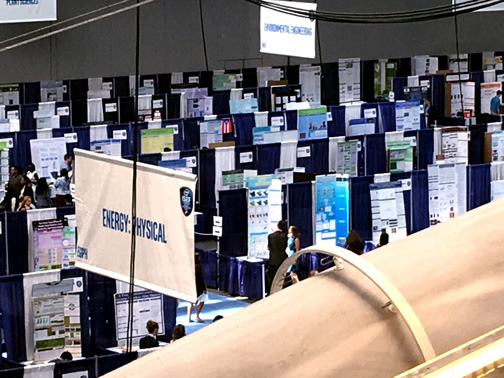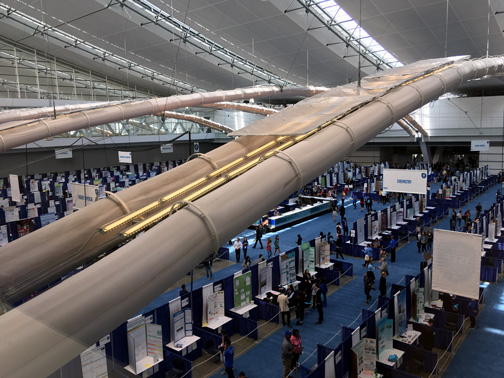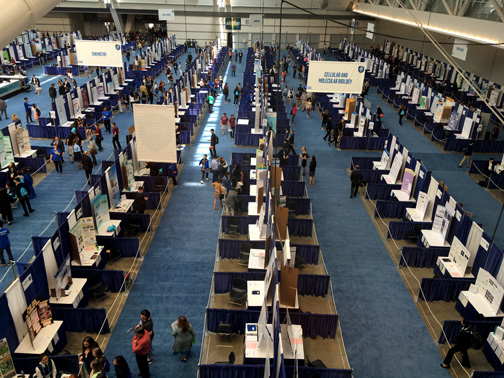Team NYC sent 14 students off to the 2018 Intel International Science and Engineering Fair (ISEF) in Pittsburgh, Pennsylvania last week. By noon Friday, they had collectively amassed over $22,800 in prize money. (I have to use the word "over" since some of the special awards do not have well-defined monetary values.) The awards are distributed over two days — Thursday evening is for Special Awards, sponsored by a variety of professional organizations, and Friday morning is for Grand Awards, sponsored mostly by the Intel Foundation.
The Intel ISEF is the largest pre-college science competition in the world. Each year, approximately 1,800 high school students from more than 75 countries, regions, and territories are awarded the opportunity to showcase their independent research and compete for $4 million in prizes.
 |
 |
 |
Every year, millions of students worldwide compete in local and school-sponsored science fairs. Only the best projects form these affiliated fairs are accepted into the Intel ISEF. Students in the five boroughs compete in the New York City Science and Engineering Fair (NYCSEF), a joint venture between the City University of New York and the New York City Department of Education. NYCSEF is itself a large event, with something like 450 projects passing the rigorous standards of the Scientific Review Committee. NYCSEF is so huge that it has to be broken down into two events: a preliminary round and a finals round.
Everyone who attends the Intel ISEF is automatically a winner. Walking through the doors of the convention center into the project space is a reward unto itself for months or even years of toil. An Intel ISEF is five days of practice, competition, entertainment, excitement, rewards, and new friends. What Team NYC accomplished in the week of May 13–18 is not entirely measurable. But for those of you who like hard data, here are the awards we brought back.
First Award of $3,000
- Ella Feiner (Cellular and Molecular Biology) Horace Mann School
Project: Exploring Posterior Growth in D. rerio Using a Live Cell Cycle Biosensor.
Ella's project was declared Best of Category in Cellular and Molecular Biology, which comes with an additional $5,000. She also received an all-expense paid four week trip and scholarship to the Bessie Lawrence International Summer Science Institute from the American Committee for the Weizmann Institute of Science.
Second Award of $1,500
- Suha Hussain (Systems Software) Queens High School for the Sciences at York College
Project: A New Method for the Exploitation of Speech Recognition Systems.
Suha received four special awards: a Fourth Award of $500 from the Association for Computing Machinery, a $1,500 Data Award from GoDaddy, a $1,000 Second "Science Security" Award from the National Security Agency Research Directorate, and a $1,800 STEM Cloud Award in Systems Software from the Shanghai STEM Cloud Center. - Eeshan Tripathii (Environmental Engineering) The Dalton School
Project: The Air We Breathe: Reducing Health Risks by Improving IAQ: An Innovative, Smart, and Responsive Ductless System Optimized by Stochastic Simulation and Machine Learning.
Eeshan also received a $1,000 Thermo Fisher PPI Award "for driving Practical Process Improvement in science".
Third Award of $1,000
- Timur (Timmy) Ibragimov (Physics and Astronomy) Staten Island Technical High School
Project: Stochasticity on Astronomical Scales: A Half-life formalism for Predicting the Disruption of Small-N Body Systems.
Timmy also received a $2,500 First Award from the National Aeronautics and Space Administration (NASA). - Vera Zarubin (Materials Science) Bronx High School of Science
Project: Novel Fabrication of Organic Multifunctional Materials via Magnetic Alignment
Fourth Award of $500
- Brendon Choy (Chemistry) Hunter College High School
Project: Cutting off Cancer: Design, Analysis, and Synthesis of Novel Vascular Disrupting Agents. - Ryan Bose Roy (Translational Medical Science) Hunter College High School
Project: Novel Warning Mechanism for At-Risk Stroke and Epilepsy Patients Through Detection of Harmful Levels of Cortisol. - Alexandria Ang (Earth and Environmental Sciences) Bronx High School of Science
Project: A Destructive Invader: How Rising Atmospheric CO2 Is Aiding Noctiluca scintillans in Taking Over Tropical Oceans.
Special Awards
- Brian Wu & Bi Tian (Jack) Yuan (Physics and Astronomy) Horace Mann School & Columbia Preparatory School
Project: Finding the Next Tatooine: Discovery of Giant Planets, Brown Dwarfs, and the First-Ever Circumbinary Planet Using Doppler Spectroscopy.
Brian and Jack each received a Renewable Tuition Scholarship Award to West Virginia University. - Phoebe Yates (Behavioral and Social Sciences) Institute for Collaborative Education
Project: The Impact of Emotionally Targeted Branding on Social Behavior.
Pheobe also received a Certificate of Honorable Mention and a one-year student membership with the American Psychological Association.
Participants
- Aushna Saleem (Animal Sciences) Midwood High School at Brooklyn College
Project: The Effects of Monk Parakeet Age on Sociality. - Ari Firester (Environmental Engineering) Hunter College High School
Project: Desalinating Water Using Electric Fields. - Hanna Yip (Robotics and Intelligent Machines) The Spence School
Project: A Fast and Accurate Open-Source Solo Musical Instrument Classifier.